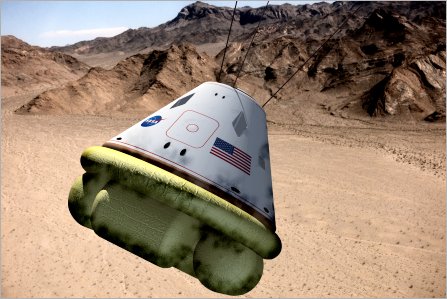ROB COPPINGER / LONDON
A rethink of the way vehicle’s crew capsule is recovered is the latest change in NASA’s future exploration plans
The landing system for the Crew Exploration Vehicle (CEV) is the latest part of NASA’s planned Exploration Transportation System (ETS) to undergo re-evaluation as the US agency continues to study its options.
The ETS consists of the four/six-crew CEV capsule, its CLV booster and the Cargo Launch Vehicle (CaLV), which will carry the Earth departure stage (EDS) and lunar surface access module into orbit.
|
| The current landing system includes parachutes, airbags and retro-rockets |
NASA has already reduced the diameter of the crew capsule from 5.5m (18ft) to 5m, and in late March the agency cancelled its procurement for the CEV’s landing system parachutes.
“We had to take a step back on the landing system, [and] 5m gives us more margin in the overall mass of the [CEV/CLV] stack,” says Michael Hecker, who this month leaves his post as director of the Constellation Systems division within NASA’S exploration systems mission directorate.
Another change is the decision to use Pratt & Whitney’s J-2X engine for the CLV’s upper stage. This derivative of an Apollo-era engine has also been selected to power the EDS.
The decision was driven by life-cycle cost, says Hecker. The J-2X will be cheaper, but its performance is not as good as that of the expendable RS-25e version of the Space Shuttle main engine originally considered.
Hecker rejects reports that CLV development costs are spiralling towards $3 billion, but he accepts that the move to a five-segment, rather than four-segment, solid rocket booster for the first stage will increase development costs.
Life-cycle cost also drove selection of the Rocketdyne RS-68 as the CaLV’s main engine, rather than the RS-25e. However, this led to an increase in CaLV core structure diameter from 8.38m, the same as the Shuttle’s external tank, to 10m. The wider core was needed to enlarge the fuel tanks to provide the extra propellant required to allow the RS-68 to burn long enough to deliver RS-25e-like performance.
Hecker says the agency’s Michoud Assembly Facility, near New Orleans, can manufacture a 10m structure because “the tooling already exists so the increase in cost is negligible”. Michoud, a NASA centre managed by Lockheed Martin, is already designated to be the manufacturing and assembly facility for the CLV upper stage and EDS.
Hecker expects the ETS option studies to end with the systems requirements review in September, following selection of a CEV prime contractor in August. The delay in downselect from May to August was due to the arrival of Scott Horowitz as head of NASA’s exploration systems mission directorate and a belief that more trade studies needed to be done with the competing consortia.
Source: Flight International

















